All Things Expo: Our Experiences of the World Expo 2025 in Osaka Japan
- Kimberly OLeary
- Sep 7
- 12 min read
Updated: Sep 7

We returned to Japan this summer in part because we wanted to see the World Expo in Osaka. We’re so glad we came back. In addition to other wonderful experiences in Osaka (more on that in the next blog post), we have been to Expo 4 times. We have learned a few things about navigating Expo that we’d like to share in this blog post. There's still time to go, if you're near Osaka. It will be open another 5 weeks!
Below are bullet points of information. Click on a topic to read more about it.
What is a World Expo?
This year, 2025, Osaka, Japan is hosting the World Expo, and 158 countries are participating (there are 195 countries in the world). This is the second Expo for Osaka, the first being in 1970. The next World Expo will be in Riyadh, Saudi Arabia in 2030. The first World Expo was in 1891 in Prague, Bohemia (now part of the Czech Republic). In America, we tend to call it a World’s Fair, but the French term, Exposition Universelle (shortened to Expo), is used in most of the rest of the world. In modern times, an international Expo is held every five years, and generally includes participation by many countries, who build exhibits and temporary structures. The host country is responsible for planning a site, logistics, and supplemental structures and amenities.

What are the dates for the World Expo in Osaka, 2025, and what is the theme?
The Expo started April 13 and will last until October 13, 2025. The theme is "Designing Future Society for Our Lives," with three core sub-themes: "Saving Lives," "Empowering Lives," and "Connecting Lives”. The very Japanese mascot is Myaku Myaku, whose parts consist of red blood cells and blue water. The name means “a coursing pulse.” This is what Myaku Myaku looks like:
What is the best way to get to 2025 Expo in Osaka?
The most common way to get to Expo is by taking the Chuo line on the subway, which is inexpensive. For example, from our Airbnb in Suwanomori, taking 3 train/subway lines, the total cost is about Y900 each way (currently about $6 USD). Osaka built a new station, Yumeshima, and it is modern and efficient. You can connect to that subway line from many other train lines, including the JR line, other subway lines, and commuter trains such as the Nankai line. If you take the subway, you should enter at the East Gate (you designate the gate when you buy the ticket). Another way to get there is by shuttle bus, which arrives at the West Gate. Shuttles originate in several large stations such as Shin-Osaka and Namba stations. Shuttles can be very convenient for several reasons. First, the West Gate is a less crowded way to enter. Second, although not as inexpensive as the subway, the tickets are reasonably priced. We realized (too late) we could have taken a shuttle from Sakai Station, close to where we are staying, for about Y1300 each way (currently about $8.75 USD). This slight difference in price would have been well worth the convenience of a)not changing train lines b) not leaving with a huge crowd of other people in the subway and c)getting on the shuttle bus at the end of a long day and being taken within a 10-minute distance to our Airbnb without extensive walking. If we went again, we would take the shuttle, but we had already bought tickets for the East Gate. There are also inter-city buses from other places such as Takamatsu on Shikoku Island and Kobe. There are other ways to get there that we did not explore: a friend of ours said he biked then walked across a bridge; he also said there was a ferry.
What are the costs and how do you get tickets?
There are several different kinds of tickets. The least expensive ticket is an adult evening pass for a specific day, which allows entry at 4pm and costs about Y3700 (currently about $25 USD). You can buy tickets for people with disabilities and for children for less. Next would be a weekday pass for a specific day, about Y7500 ($50 USD). You can also buy day passes that can be used for any day. We bought summer passes (valid July-August) for Y12,000 ($80 UDS) but those are no longer available. Since we went four times, that was a good deal for us. Buy tickets online here or at convenience stores in Japan. If you don’t buy a date-specific ticket, you have to request an admission date in advance. We always got the admission dates we asked for.

What Can You See?
First, there are all of the things you can see just by entering and walking around. These include the outsides of the pavilions, which are architecturally interesting, and some of which have videos displayed outside. At night, these light up into beautiful colors and at 8pm there are fireworks. We kept hearing about a drone show but event though we stayed until closing twice, we never saw it.
The iconic feature of Osaka Expo 2025 is a giant wooden ring that encircles the heart of the activity. The ring has been certified by Guiness Records as the largest wood structure in the world, and is over a mile in circumference and 12-20 meters high. The 30-meter width creates a shaded spot for people to walk under, containing a lot of wood benches, and goes around the Expo site. You can take escalators or elevators to the top and walk around, offering a beautiful view of pavilions, mountains, and the city of Osaka. The view at night is also breathtaking, and a bit cooler. We heard that after Expo is over, they will dismantle the ring and make smaller wood structures in beautiful spots throughout Japan.
Elsewhere, there are public sculptures, fountains, a small “forest”, views of mountains and sea, and lots of eating, drinking and sitting spots – ranging from food courts to food trucks to vending machines (this is Japan, after all!) There are gift shops. Expo is a cashless site so bring a credit card or Japanese ICOCA/Suica card or use your phone e-wallet.
Second, there are many sites you can enter without a reservation, and some have no line or very small lines. We walked into the Earth at Night pavilion 4 different times, and it was one of my favorite exhibits. There, you see videos of craftspeople describing how they created a giant laquer globe flecked with gold continents and islands. Then, you walk around the globe and also see cities created in a similar fashion. There are several buildings of “Commons”, which house smaller exhibits by many countries, with little or no lines. These are interesting and you can see many country exhibits in a short time. Some of the smaller pavilions such as Cambodia, Latvia/Lithuania, Vietnam, and others have virtually no line. Sometimes you see surprises – in the Vietnam exhibit, for example, we happened to walk in when a professional musician was performing on a tenor sax. Pro tip: Paul figured out that If you enter at the East Gate, but make your way to the West Gate relatively quickly, you can get into exhibits with little wait line. The West Gate is less crowded. So we saw Future City and Future Village with ease, twice – both past the West Gate. Then, we made our way back to the East Gate near closing time for a chance to enter a pavilion at 7pm and leave by subway.
Third, there are exhibits where you do not need a reservation but must wait in line. Look for a staff person holding a sign signifying the end of the line, and ask them how long the wait. I read that they “pad” the wait time by 20 extra minutes, and that seemed about right. We got into the Hungary Pavilion that way, for example.

Fourth, many pavilions open to lines at 7pm (pavilions mostly close at 8pm). We got into the Osaka Health Pavilion (but just the first floor) that way, and it was great. My advice – pick one to see that way and head there at 7.
Finally, there are popular pavilions where you must have a reservation. You can enter a reservation lottery 2 weeks before a visit, or 1 week before a visit, or the day of a visit – all online using the Expo site. We did not get any reservations when our friend tried a week before; we successfully got a Japan Pavilion reservation 2 weeks before (but none of the others we requested); we never succeeded in getting a reservation into anything on the day. Personally, I would not even try to get one for France, Saudi Arabia, USA or Gundam – they are all too popular! But hey, if you want it really, really badly, you can try! The lines into France, for example, were over two hours!!!
The best things we experienced
We loved Earth at Night, described above. There was also a nice exhibit on Japanese joinery Paul especially enjoyed. The Japanese craft exhibits tend to be less crowded. We loved the Japan Pavilion, and were happy we got tickets. It is very large, consisting of 3 parts, showcasing a working recycling plant that turns garbage into algae and algae then 3-D printed into objects. We enjoyed staying one night for the fireworks. We loved interacting with the scientists at Future Village. We ate at a restaurant in the Polish Pavilion which was nice, and had great sushi at a conveyor-belt restaurant called Kura near Future City. We also had ice cream, flavored ice, and a variety of Japanese food. We enjoyed sitting in 3-D printed huts that are made from plants and will decompose after Expo is over. We loved walking on top of the ring, taking in the beautiful flowers and looking over the tops of the pavilions. We really enjoyed every Pavilion we visited – Hungary, Latvia/Lithuania, Cambodia, two Commons buildings, Osaka Health and Future City. We learned a lot and enjoyed the sounds and the visuals.
The entire site is very clean, and there are many restrooms with surprisingly short lines given how many people were there.
The security staff were very knowledgeable and answered our questions with ease. On the two nights we left at closing, they were astonishingly organized in herding people into the subways in a way that prevented chaos. They had frequent empty trains coming and we left quickly. Likewise, on the way to Expo by subway, there were numerous signs on the walls and lines on the floor making it very easy to see how to navigate to the next train line. Additionally, security staff directed people. This is Japanese organization at its best.
Some challenges
There was a huge problem with our summer passes having to activate facial recognition. We waited over two hours the first time we went because of this problem. Part of the problem is you need to create an account, then turn off your VPN and turn on the Expo wi-fi. Another huge problem is if you make a mistake more than once entering the site you have to wait 30 minutes to try again. There was an entire building dedicated to fixing facial recognition problems. Facial recognition is not required for day passes and now that summer passes are over, it won’t be a problem going forward. But the 30-minute wait to get back into the website could still be an issue if you have to re-enter the site (which we did once, and had trouble bringing up our tickets) or when you are trying to get same-day reservations on site (which we never were able to do). The website could have worked more smoothly.
The heat was a huge challenge. Osaka is always hot and humid in the summer, but this year saw relentlessly high temperatures day after day – like much of the world. Special thanks for our friends Yuji, Mika, and Inage for helping us with cooling towels, salt tablets, and plenty of water. There are water stations in several places as well as bottled water vending machines. You can also buy drinks with electrolytes such as Pocari Sweat or Aquarius. Expo staff provided umbrellas at many of the lines, and set up some extra tents for shade. There were frequent announcements for people to drink water and take salt tablets.
It was frustrating to be unable to get into the most popular sites, even with 4 visits. But, this is a sign of how successful the Expo has been. By the mid-point, Osaka had already seen the full number of visitors they hoped to have for the entire season. The lottery system to get reserations into specific experiences seemed unnecessarily complicated.
Overall impressions
I went to Expo with the attitude, ‘What can I get?’ What pavilions can I get into? What food can I eat? What experiences can I have? What souvenirs can I buy? But after attending 4 times, I realize that was the wrong attitude. What is great about the Osaka Expo 2025 is that I can bear witness to all of the amazing ways the world is working together to make life better for everyone. We live in a time of great dissension, and it is no small thing to witness people working together for the greater good. We saw scientists bubbling over with enthusiasm to explain their ground-breaking work to us, making the extra effort to speak in English. We saw videos of Japanese crafters painstakingly creating a beautiful giant globe in laquer and gold flecks. We helped plant trees in a Latvian forest remotely. We saw medical breakthroughs and a wondrous recycling plant using natural materials. We spoke to representatives of many countries who were eager and happy to showcase how their land was helping the planet. This is what makes an Expo special, and Japan – and the Kansai region of Japan – beautifully showcased an experience of hope for the future. And, we got to see all of these things with different sets of friends, enriching our friendships. Osaka Expo 2025 is an experience we will never forget.
Conclusion
It wouldn’t be Japanese if there wasn’t a mascot and theme song. The mascot is Myaku-Myaku, which means a coursing pulse. You can see the Japanese group Kobukuro singing the theme song here, and look for Myaku Myaku to make an appearance near the end. I took my best shot at singing the theme song. Fair warning: this is one of the hardest songs I've ever learned. Between the language, the rhythm, and the chords, there are a couple of pretty rough spots, but I think you do get the idea of the song and I did enjoy singing it. You can see me sing it here.
Lyrics translated into English with phonetic Japanese:
Official Theme Song of the Osaka-Kansai Expo
Ōsaka Kansai banpaku ofisharutēmasongu
"Continuation of This Earth (Star)"
Lyrics and Composition: Kentaro Obuchi and Shunsuke Kuroda
Arrangement: Kobukuro
大阪・関西万博 オフィシャルテーマソング
「この地球(ほし)の続きを」
作詞・作曲:小渕健太郎・黒田俊介 編曲:コブクロ
(2025: Let's go see the future!)
2025 Mirai mi ni ikou!
Can you imagine a century from now, when flying in the sky will be the norm?
Atari mae ni sora o toberu 100 nen sakio sōzō dekirukai ?
(2025, let's go see the future!)
2025 Mirai mi ni ikou!
Someone's dream, laughed at 100 years ago, is driving the present.
100 nen mae ni warawareteta dare ka no yume ga ima o ugokashiteru
Our eye color and words are different.
Shitomi no iro mo kotoba mo
But we surely share the same wish.
Chiga-u dakedo onaji negai o motteiru hazu
Hello, cherry blossoms are blooming.
Konnichiwa sakura saku
Hello, the curtain is rising.
Konnichiwa maku ga hiraku
Hello, this life resonates across the ocean.
Konnichiwa umi o koe
This planet, this life, continues to shine.
Kono inochiwa hibikiau
The world we dreamed of back then is no longer an illusion. Kagayakinagara kono hoshi wa kono inochi wa tsuzuku
A brilliant innovation.
Ano hi yumemita sekai wa mō gensō janai nodeshō azayakana inobēshon
(2025, let's go see the future!)
( 2025 Mirai mi ni ikou! )
Hello, cherry blossoms are blooming.
Konnichiwa sakura saku
Hello, the curtain is rising.
Konnichiwa maku ga hiraku
Hello, this life resonates across the ocean.
Konnichiwa umi o koe
Hello, cherry blossoms are dancing. This planet, this life, is alive.
Kono inochi wa hibikiau
Hello, cherry blossoms are dancing,
Konnichiwa, sakura mau,
Hello, this planet, this life, is alive.
Kono hoshi wa itikiteiru
Hello, someday, a whole new world. I continue to dream of the day I can fly.
konnichiwa itsu no hi ka A Whole New World toberu hi o yumemitsuzukeru
Children are changing the continuation of this planet.
kodomotachi ga kaeteyuku kono ( hoshi ) no tsuzuki o
(2025, let's go see the future!)
Mirai mi ni ikou!
(2025, let's go see the future!)
( 2025 Mirai mi ni ikou!)
大阪・関西万博 オフィシャルテーマソング
「この地球(ほし)の続きを」
作詞・作曲:小渕健太郎・黒田俊介 編曲:コブクロ
(2025 未来見に行こう!)
当たり前に 空を飛べる 100年先を想像できるかい?
(2025 未来見に行こう!)
100年前に 笑われてた 誰かの夢が 今を動かしてる
瞳の色も言葉も 違う
だけど 同じ願いを持っているはず
こんにちは 桜咲く こんにちは 幕が開くこんにちは 海を越え この命は 響き合う
輝きながら この地球(ほし)は この命は 続く
あの日夢見た世界は もう
幻想じゃないのでしょう 鮮やかなイノベーション
(2025 未来見に行こう!)
こんにちは 桜咲く こんにちは 幕が開くこんにちは 海を越え この命は 響き合う
こんにちは 桜舞う この地球(ほし)は 生きている
こんにちは いつの日か A Whole New World 飛べる日を 夢見続ける
子供達が変えてゆく この地球(ほし)の続きを
(2025 未来見に行こう!)
(2025 未来見に行こう!)
































































































































































































































































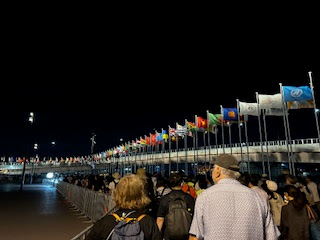






















Comments